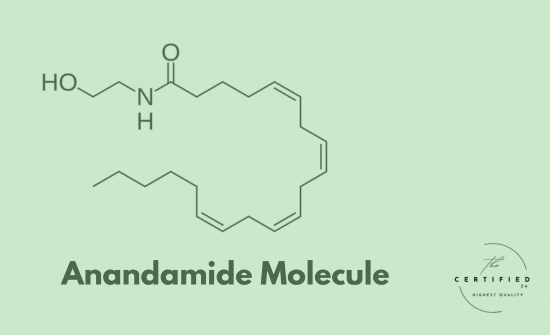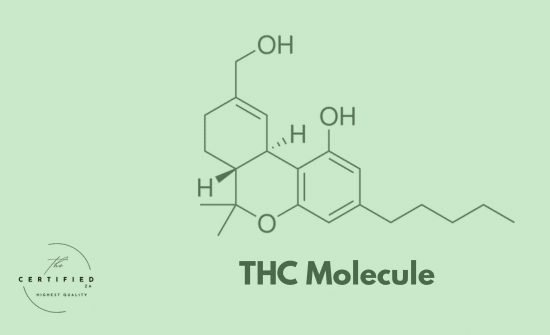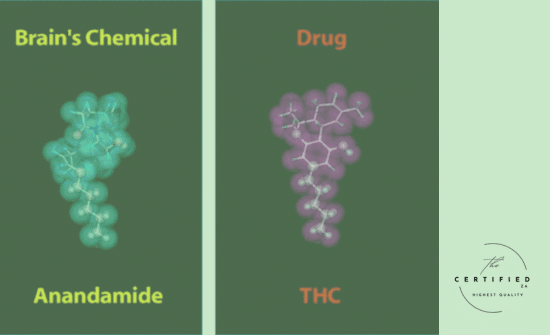
In the vast landscape of the human body’s biochemistry, few molecules have as intriguing a name as anandamide. Derived from the Sanskrit word “ananda,” meaning “internal bliss” or “joy,” this compound is a cornerstone of a critical regulatory network known as the Endocannabinoid System (ECS). While the ECS gained fame through its connection to cannabis, understanding anandamide itself is key to unlocking the science behind our body’s sense of balance, well-being, and how it responds to cannabinoids like THC and CBD.
This post will dive into what anandamide is, how it functions within your body, and its intricate relationship with cannabis, from the plant’s psychoactive effects to its therapeutic potential.
What is Anandamide?
Anandamide (AEA) is an endocannabinoid, meaning it’s a cannabinoid-like molecule produced inside your body. Discovered in the early 1990s, it was one of the first endogenous “keys” found that fit the “locks” of the cannabinoid receptors, which had just been identified as the primary targets of THC.
Anandamide was the proof. It was the body’s own, internally produced molecule that perfectly fit into the CB1 receptor lock. This confirmed that the cannabinoid receptors weren’t just for cannabis; they were part of a vast, pre-existing communication network essential for our health – The Endocannabinoid System.
So, when we say:
“Anandamide (AEA) was one of the first endogenous ‘keys’ found that fit the ‘locks’ of the cannabinoid receptors, which had just been identified as the primary targets of THC.”
We are saying this:
Scientists first found the “lock” (the CB1 receptor) by seeing where THC from cannabis was binding in the brain.
They correctly assumed our bodies must have a natural reason for these locks.
They then discovered Anandamide – the first internally-produced “key” that our body makes to regulate itself by unlocking these same receptors.


Unlike traditional neurotransmitters that are stored in vesicles and released when needed, anandamide is synthesised on demand. When your body senses a need to restore balance, whether in response to stress, pain, or inflammation, your cells produce and release anandamide. It has a short half-life and is quickly broken down by an enzyme called Fatty Acid Amide Hydrolase (FAAH). This rapid synthesis and degradation allow for precise, localised control over various physiological processes.
The Role of Anandamide and the Endocannabinoid System
Anandamide and the broader ECS act as a master regulatory system, helping to maintain homeostasis (internal balance). Research has shown it plays a vital role in modulating a wide range of functions:
- Mood and Anxiety: Studies have consistently linked higher anandamide levels with reduced anxiety. Research in both animal models and humans has shown that elevating anandamide levels, for instance through exercise or by inhibiting the FAAH enzyme, produces anxiolytic (anxiety-reducing) effects. In fact, some individuals with naturally higher anandamide levels (due to a genetic variation in the FAAH enzyme) self-report lower anxiety.
- Pain and Inflammation: The ECS is deeply involved in modulating pain signals and inflammatory responses. Anandamide can help regulate these processes, which is why cannabinoid-based therapies are being explored for pain management and inflammatory conditions.
- Reward and Motivation: The ECS, including anandamide, plays a modulatory role in the brain’s reward circuitry. It can influence how we experience pleasure and motivation, a factor that is central to research on addiction and substance use disorders.
- Sleep: As some of the provided research highlights, anandamide is also implicated in sleep regulation. Studies have shown that administration of anandamide can induce sleep and increase slow-wave (deep) sleep, possibly by influencing adenosine levels, another key sleep-promoting molecule.
- Appetite and Metabolism: Anandamide is known to stimulate appetite, a well-known effect also associated with THC.

The Connection to Cannabis: How THC and CBD Interact with Anandamide
The cannabis plant produces phytocannabinoids (plant-based cannabinoids) that interact with our ECS, often by mimicking or influencing anandamide.
- THC and Anandamide: THC, the main psychoactive component of cannabis, is a partial agonist of the CB1 receptor – the same receptor that anandamide activates. Essentially, THC fits into the same “lock” as anandamide, but it does so more powerfully and for a longer duration, as it’s not broken down as quickly. This strong activation of CB1 receptors, particularly in the brain, is what produces the euphoric “high” and other effects associated with cannabis, such as increased appetite and altered perception. Chronic, heavy cannabis use can lead to the brain downregulating its CB1 receptors to compensate for this constant stimulation. In turn, this can lead to lower anandamide levels in some individuals, a finding that is particularly relevant in studies of cannabis use disorder.
- CBD and Anandamide: Unlike THC, CBD does not bind strongly to CB1 receptors and is non-intoxicating. Instead, one of its primary mechanisms of action is to inhibit the FAAH enzyme, the very enzyme that breaks down anandamide. By slowing down FAAH’s activity, CBD can lead to an increase in your body’s own anandamide levels. This is a crucial distinction: instead of directly activating the receptors like THC, CBD helps boost your natural “bliss molecule.”
This FAAH-inhibiting action is a key hypothesis behind many of CBD’s potential therapeutic benefits. For example, research has explored CBD’s role in treating psychiatric disorders. A recent clinical trial investigated this very mechanism in individuals with cannabis use disorder, looking at how CBD administration affects plasma anandamide levels. The study found that an 800 mg dose of CBD appeared to protect against reductions in anandamide levels that were observed in the placebo group during a cannabis cessation attempt. By potentially increasing anandamide signalling, CBD may help alleviate symptoms of anxiety, psychosis, and withdrawal, offering a promising avenue for treatment.

The Takeaway: A Molecule of Balance
Anandamide is more than just our body’s “bliss molecule”; it is a fundamental regulator of our physiological and psychological well-being. It represents the delicate balance our system constantly strives to maintain. The cannabis plant, through compounds like THC and CBD, offers us a way to directly interact with this system. THC acts as a powerful external key, while CBD works more subtly, by helping our own natural key, anandamide, stay in the lock a little longer.
Understanding the role of anandamide deepens our appreciation for both the complexity of our own biology and the profound ways in which cannabis can influence it. Whether you’re a medical user seeking relief or a recreational consumer exploring different experiences, recognising the interplay between anandamide, THC, and CBD can empower you to make more informed and mindful choices on your cannabis journey.
